Nazareth was the one Palestinian
city in Israel whose inhabitants were not evicted in the Naqba. Jonathan Cook tells the fascinating story of
why Nazareth’s inhabitants escaped the massacres and expulsions. He also tells the story of how Upper Nazareth
was founded, as a way of confining and suffocating Nazareth. In Upper Nazareth today, founded a Jewish only
city, the Mayor Shimon Gapso has banned the celebration
of Christmas.
city in Israel whose inhabitants were not evicted in the Naqba. Jonathan Cook tells the fascinating story of
why Nazareth’s inhabitants escaped the massacres and expulsions. He also tells the story of how Upper Nazareth
was founded, as a way of confining and suffocating Nazareth. In Upper Nazareth today, founded a Jewish only
city, the Mayor Shimon Gapso has banned the celebration
of Christmas.
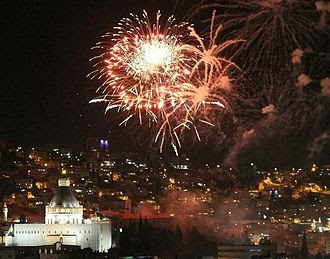 |
| Christmas in Nazareth |
Israels
+972 Magazine reports how, when Palestinian residents approached Gapso, and requested that a Christmas
tree be put up, since there were 3 large menorahs (candelabrums) erected to
celebrate the Jewish festival of Chanukah, Gapso, reports Israeli news site NRG
(owned by Maariv), refused. “Upper
Nazareth is a Jewish town and all its symbols are Jewish., As long as I hold
office, no non-Jewish symbol will be presented in the city.”
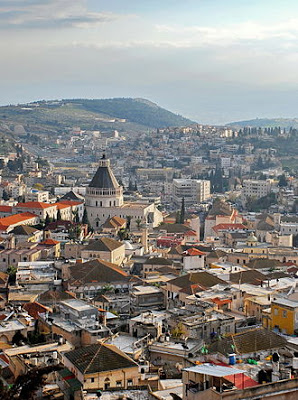 |
| modern Nazareth |
In
2010 Gapso proclaimed that the public display of the Christian symbol as
provocative and banned Xmas trees from public squares. “Nazareth Illit is a Jewish city and it will
not happen — not this year and not next year, so long as I am a mayor”.
2010 Gapso proclaimed that the public display of the Christian symbol as
provocative and banned Xmas trees from public squares. “Nazareth Illit is a Jewish city and it will
not happen — not this year and not next year, so long as I am a mayor”.
Racism? Perish the thought.
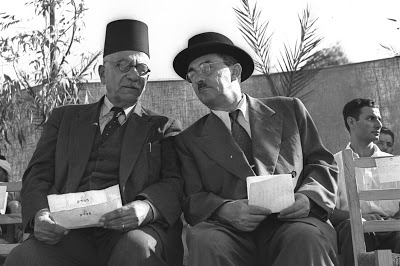 |
| Moshe Sharett, Israel’s Prime Minister and Amin Gargurah, Mayor of Nazareth |
Why Israel has silenced the 1948 story of Nazareth’s survival
12
January 2016
January 2016
A
rarely told story of the 1948 war that founded Israel concerns Nazareth’s
survival. It is the only Palestinian city in what is today Israel that was not
ethnically cleansed during the year-long fighting. Other cities, such as Jaffa,
Lydd, Ramleh, Haifa and Acre, now have small Palestinian populations that
mostly live in ghetto-like conditions in what have become Jewish cities. Still
others, like Tiberias and Safad, have no Palestinians left in them at all.
rarely told story of the 1948 war that founded Israel concerns Nazareth’s
survival. It is the only Palestinian city in what is today Israel that was not
ethnically cleansed during the year-long fighting. Other cities, such as Jaffa,
Lydd, Ramleh, Haifa and Acre, now have small Palestinian populations that
mostly live in ghetto-like conditions in what have become Jewish cities. Still
others, like Tiberias and Safad, have no Palestinians left in them at all.
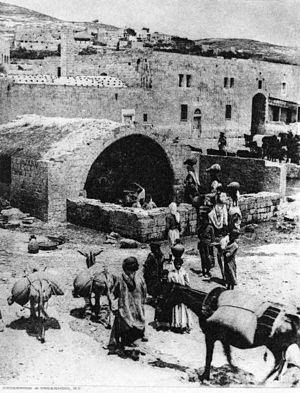 |
| Historic photo of Mary’s Well |
Nazareth
was not only an anomaly; it was a mistake. It was supposed to be cleared of its
Palestinian population, just like those other Palestinian cities now in Israel.
Much to Israel’s regret, it has become an unofficial capital for Israel’s 1.6
million Palestinian citizens, a fifth of the Israeli population.
was not only an anomaly; it was a mistake. It was supposed to be cleared of its
Palestinian population, just like those other Palestinian cities now in Israel.
Much to Israel’s regret, it has become an unofficial capital for Israel’s 1.6
million Palestinian citizens, a fifth of the Israeli population.
The
reason for Nazareth’s survival are the actions of one individual. Ben
Dunkelman, a Canadian Jew who was the commander of the Israeli army’s Seventh
Armoured Brigade, disobeyed orders to expel Nazareth’s residents.
reason for Nazareth’s survival are the actions of one individual. Ben
Dunkelman, a Canadian Jew who was the commander of the Israeli army’s Seventh
Armoured Brigade, disobeyed orders to expel Nazareth’s residents.
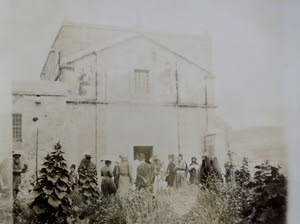 |
| Church in Nazareth on site of Joseph’s workshop, 1891 |
Dunkelman’s
role has been largely obscured in the historical record – and for good reason.
Israel would prefer that observers make an unjustified assumption: that
“Christian” Nazareth survived, unlike other Palestinian cities, because its
leaders were less militant or because they preferred to surrender. Dunkelman’s
story proves that was not the case.
role has been largely obscured in the historical record – and for good reason.
Israel would prefer that observers make an unjustified assumption: that
“Christian” Nazareth survived, unlike other Palestinian cities, because its
leaders were less militant or because they preferred to surrender. Dunkelman’s
story proves that was not the case.
It
is therefore a welcome development that a major Canadian newspaper, the Toronto
Star, has revisited Dunkelman’s role in Nazareth, even if its reporter, Mitch
Potter, has contributed in his own way to the mythologising of Dunkelman in an
article headlined: “The Toronto man who saved Nazareth”.
is therefore a welcome development that a major Canadian newspaper, the Toronto
Star, has revisited Dunkelman’s role in Nazareth, even if its reporter, Mitch
Potter, has contributed in his own way to the mythologising of Dunkelman in an
article headlined: “The Toronto man who saved Nazareth”.
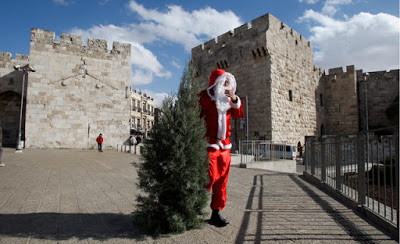 |
| Xmas tree banned in Nazareth Illit |
Excised memories
It
is worth bearing in mind, when we consider the attacks on Palestinian cities in
1948, how sensitive these matters were for Israel. Both Dunkelman and another
commander, Yitzhak Rabin, who would later become a prime minister, wrote
memoirs that included their experiences of the 1948 war.
is worth bearing in mind, when we consider the attacks on Palestinian cities in
1948, how sensitive these matters were for Israel. Both Dunkelman and another
commander, Yitzhak Rabin, who would later become a prime minister, wrote
memoirs that included their experiences of the 1948 war.
Under
pressure from the Israeli military authorities, both excised from their
accounts the sections they had written dealing with the attacks on the
Palestinian cities they were responsible for attacking. That was because those
accounts were the proof, long denied by Israel and its supporters, that the Israeli
leadership had intended and carried out the ethnic cleansing of most of the
Palestinian population during 1948.
pressure from the Israeli military authorities, both excised from their
accounts the sections they had written dealing with the attacks on the
Palestinian cities they were responsible for attacking. That was because those
accounts were the proof, long denied by Israel and its supporters, that the Israeli
leadership had intended and carried out the ethnic cleansing of most of the
Palestinian population during 1948.
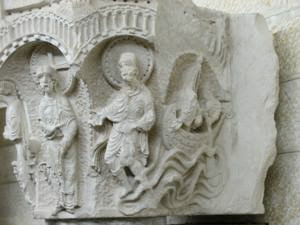 |
| Crusader-era carving in Nazareth |
Some
750,000 Palestinians – out of 900,000 living inside the borders of what was to
become the new Jewish state – were forced out and refused the right to return.
In fact, the expulsion rate was far higher than the ostensible 80 per cent
figure. Under pressure from the Vatican, Israel allowed many Christian refugees
back; it did a land swap with Jordan in 1949 that brought more than 30,000 Palestinians
into the new state; and many Palestinian refugees managed to sneak back to
surviving communities like Nazareth and blend in with the local population in
preparation for what they hoped would be their return to their villages.
750,000 Palestinians – out of 900,000 living inside the borders of what was to
become the new Jewish state – were forced out and refused the right to return.
In fact, the expulsion rate was far higher than the ostensible 80 per cent
figure. Under pressure from the Vatican, Israel allowed many Christian refugees
back; it did a land swap with Jordan in 1949 that brought more than 30,000 Palestinians
into the new state; and many Palestinian refugees managed to sneak back to
surviving communities like Nazareth and blend in with the local population in
preparation for what they hoped would be their return to their villages.
Rabin
led the attack on the Palestinian cities of Lydd and Ramleh, near Tel Aviv and
today the mostly Jewish cities of Lod and Ramla. According to the missing
section of his autobiography, later publicised in the New York Times, Rabin asked David Ben Gurion, Israel’s first prime
minister, what to do with the 50,000 inhabitants of Lydd and Ramleh. Rabin
recounted: “Ben Gurion waved his hand in a gesture that said: ‘Drive them
out!’” Rabin did exactly that, after a terrible massacre of hundreds of
residents who were sheltering in a local mosque.
led the attack on the Palestinian cities of Lydd and Ramleh, near Tel Aviv and
today the mostly Jewish cities of Lod and Ramla. According to the missing
section of his autobiography, later publicised in the New York Times, Rabin asked David Ben Gurion, Israel’s first prime
minister, what to do with the 50,000 inhabitants of Lydd and Ramleh. Rabin
recounted: “Ben Gurion waved his hand in a gesture that said: ‘Drive them
out!’” Rabin did exactly that, after a terrible massacre of hundreds of
residents who were sheltering in a local mosque.
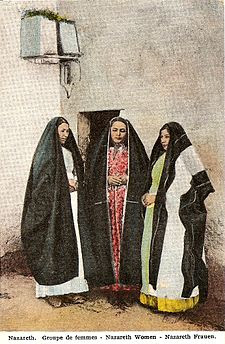 |
| Old postcard of Nazareth women |
Ben
Gurion, as the Israeli historian of the period Ilan Pappe has noted in his book
The Ethnic Cleansing of Palestine, was careful not to leave a paper trail
showing that he had ordered the expulsion of Palestinians. Instead, Israel
would promote the myth that the Palestinian population had been ordered by
neighbouring Arab leaders to flee.
Gurion, as the Israeli historian of the period Ilan Pappe has noted in his book
The Ethnic Cleansing of Palestine, was careful not to leave a paper trail
showing that he had ordered the expulsion of Palestinians. Instead, Israel
would promote the myth that the Palestinian population had been ordered by
neighbouring Arab leaders to flee.
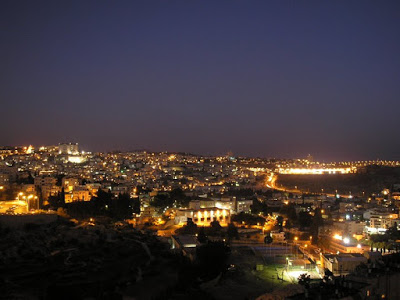 |
| The Skylight of Modern Nazareth |
Relieved of command
We
do not know if Dunkelman had a similar meeting with Ben Gurion. What we do
know, and the Star’s account confirms, is that it had been made clear to
Dunkelman that he was supposed to expel the inhabitants of Nazareth. Dunkelman
disobeyed, and allowed the city to surrender. He was relieved of his command in
Nazareth a day later.
do not know if Dunkelman had a similar meeting with Ben Gurion. What we do
know, and the Star’s account confirms, is that it had been made clear to
Dunkelman that he was supposed to expel the inhabitants of Nazareth. Dunkelman
disobeyed, and allowed the city to surrender. He was relieved of his command in
Nazareth a day later.
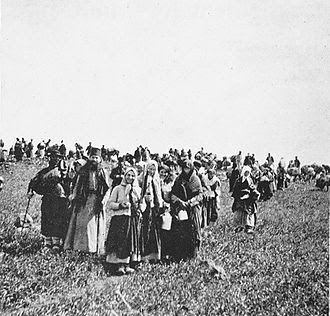 |
| Russian pilgrims approaching Nazareth. circa 1904 |
The
Star reports on a page referring to the attack on Nazareth that was removed
from Dunkelman’s 1976 memoir, Dual Allegiance. We know about it only because
his ghostwriter, the late Israeli journalist Peretz Kidron, tried to interest
the New York Times in Dunkelman’s story, as a counterpart to Rabin’s. The Times
published the Rabin story but ignored Dunkelman’s.
Star reports on a page referring to the attack on Nazareth that was removed
from Dunkelman’s 1976 memoir, Dual Allegiance. We know about it only because
his ghostwriter, the late Israeli journalist Peretz Kidron, tried to interest
the New York Times in Dunkelman’s story, as a counterpart to Rabin’s. The Times
published the Rabin story but ignored Dunkelman’s.
Interestingly,
Dunkelman kept the account of his role in the Nazareth attack so quiet that,
according to their quotes in the Star, neither his son nor his publisher at
Macmillan knew about it.
Dunkelman kept the account of his role in the Nazareth attack so quiet that,
according to their quotes in the Star, neither his son nor his publisher at
Macmillan knew about it.
Dunkelman
writes that he was “shocked and horrified” at the order to depopulate Nazareth.
He told his superior, Haim Laskov: “I would do nothing of the sort.” He
demanded that his replacement give his “word of honour” that the inhabitants
would be allowed to stay, and concludes: “It seems that my disobedience did
have some effect … It seems to have given the high command time for second
thoughts, which led them to the conclusion that it would indeed be wrong to
expel. There was never any more talk of the evacuation plan, and the city’s
Arab citizens have lived there ever since.”
writes that he was “shocked and horrified” at the order to depopulate Nazareth.
He told his superior, Haim Laskov: “I would do nothing of the sort.” He
demanded that his replacement give his “word of honour” that the inhabitants
would be allowed to stay, and concludes: “It seems that my disobedience did
have some effect … It seems to have given the high command time for second
thoughts, which led them to the conclusion that it would indeed be wrong to
expel. There was never any more talk of the evacuation plan, and the city’s
Arab citizens have lived there ever since.”
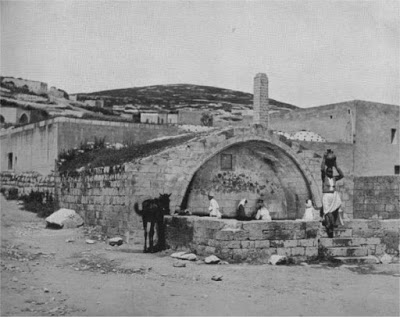 |
| Nazareth-The-Fountain-of-the-Virgin-1894 |
‘Swallowing’ Nazareth
In
fact, we know what those “second thoughts” were. Stripped of a pretext to
justify expulsions from Nazareth in the supposed “heat of battle”, Ben Gurion
came up with Plan B (or maybe it was Plan E, given that the ethnic cleansing
was inspired by Plan Dalet, or D in Hebrew).
fact, we know what those “second thoughts” were. Stripped of a pretext to
justify expulsions from Nazareth in the supposed “heat of battle”, Ben Gurion
came up with Plan B (or maybe it was Plan E, given that the ethnic cleansing
was inspired by Plan Dalet, or D in Hebrew).
In
the wake of the 1948 war, during a near two-decade period of military
government imposed on Israel’s new Palestinian minority, Ben Gurion decided to
establish Nazareth Ilit (Upper Nazareth) almost on top of Nazareth. It was the
flagship of his “Judaisation of the Galilee” campaign. Ben Gurion was aghast
not only that Nazareth had survived, but that it had doubled in size as
thousands of refugees from surrounding villages fled to it seeking sanctuary.
the wake of the 1948 war, during a near two-decade period of military
government imposed on Israel’s new Palestinian minority, Ben Gurion decided to
establish Nazareth Ilit (Upper Nazareth) almost on top of Nazareth. It was the
flagship of his “Judaisation of the Galilee” campaign. Ben Gurion was aghast
not only that Nazareth had survived, but that it had doubled in size as
thousands of refugees from surrounding villages fled to it seeking sanctuary.
According
to Israeli state archives, Michael Michael, the military governor for Nazareth
in this period, stated that the goal of Nazareth Ilit was to “swallow up”
Nazareth. In short, Israel hoped retrospectively to destroy Nazareth as a
Palestinian city, transforming it into another Lydd. The Jewish city of
Nazareth Ilit would become with the main city, with Nazareth its own shadow
ghetto. Despite Israel’s best efforts, it largely failed in this goal, not
least because it struggled to attract Israeli Jews to live next to a large
Palestinian population .
to Israeli state archives, Michael Michael, the military governor for Nazareth
in this period, stated that the goal of Nazareth Ilit was to “swallow up”
Nazareth. In short, Israel hoped retrospectively to destroy Nazareth as a
Palestinian city, transforming it into another Lydd. The Jewish city of
Nazareth Ilit would become with the main city, with Nazareth its own shadow
ghetto. Despite Israel’s best efforts, it largely failed in this goal, not
least because it struggled to attract Israeli Jews to live next to a large
Palestinian population .
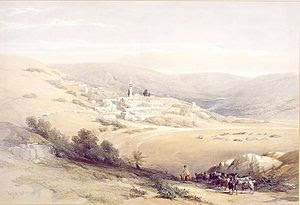 |
| Nazareth, 1842 |
Why
was it so important for the Israeli leadership to destroy Nazareth? Because
they feared that a Palestinian city – with its intellectuals, political
activists, and advanced education system under the control of international
Christian institutions – might encourage the emergence of an effective
resistance, one that would be able to mount opposition to a state privileging
Jews. Such a political and cultural capital might articulate to the outside
world exactly what Israel was up to in Judaising places with large Palestinian
populations like the Galilee.
was it so important for the Israeli leadership to destroy Nazareth? Because
they feared that a Palestinian city – with its intellectuals, political
activists, and advanced education system under the control of international
Christian institutions – might encourage the emergence of an effective
resistance, one that would be able to mount opposition to a state privileging
Jews. Such a political and cultural capital might articulate to the outside
world exactly what Israel was up to in Judaising places with large Palestinian
populations like the Galilee.
Mortar barrages
The
Toronto Star’s starry-eyed account of Dunkelman includes the following
observation: “He won no medals for refusing to molest civilians [in Nazareth],
nor any credit from his Israeli superiors.” He is painted as a man who stuck
close to the rules of war and avoided hurting civilians wherever possible in a
series of “almost bloodless” attacks.
Toronto Star’s starry-eyed account of Dunkelman includes the following
observation: “He won no medals for refusing to molest civilians [in Nazareth],
nor any credit from his Israeli superiors.” He is painted as a man who stuck
close to the rules of war and avoided hurting civilians wherever possible in a
series of “almost bloodless” attacks.
But
in fact, as the Star notes in passing, Dunkelman’s chief military talent was
for making innovative use of “concentrated mortar barrages”, a skill he learnt
during the Second World War. In other words, he was an expert at firing large
numbers of imprecise shells into populated areas, inevitably killing and
wounding civilians.
in fact, as the Star notes in passing, Dunkelman’s chief military talent was
for making innovative use of “concentrated mortar barrages”, a skill he learnt
during the Second World War. In other words, he was an expert at firing large
numbers of imprecise shells into populated areas, inevitably killing and
wounding civilians.
Two
Canadians have published posts making important criticisms of the Star’s
account.
Canadians have published posts making important criticisms of the Star’s
account.
Peter
Larson, chair of Canada’s National Education Committee on Israel-Palestine, points out that the operation in July 1948 led by Dunkelman was
an attack on communities like Nazareth that were supposed to be firmly part of
an Arab state under the terms of the United Nations Partition Plan, set out
nine months earlier. As Larson writes, “Nazareth was forcibly incorporated into
the new State of Israel contrary to the UN plan and despite the wishes of its
residents.”
Larson, chair of Canada’s National Education Committee on Israel-Palestine, points out that the operation in July 1948 led by Dunkelman was
an attack on communities like Nazareth that were supposed to be firmly part of
an Arab state under the terms of the United Nations Partition Plan, set out
nine months earlier. As Larson writes, “Nazareth was forcibly incorporated into
the new State of Israel contrary to the UN plan and despite the wishes of its
residents.”
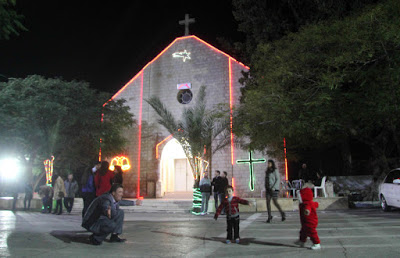 |
| Palestinian children play outside Deir Latin church in Gaza |
Protection for Christians
There
is archival evidence to suggest that Dunkelman believed Christian Palestinians
needed protecting, a view he did not extend to Muslim Palestinians.
is archival evidence to suggest that Dunkelman believed Christian Palestinians
needed protecting, a view he did not extend to Muslim Palestinians.
Israeli
historian Benny Morris notes a cable from Dunkelman as his troops marched
through the Galilee in November 1948: “I protest against the eviction of
Christians from the village of Rama and its environs. We saw Christians at Rama
in the fields thirsty for water and suffering from robbery. Other brigades
expelled Christians from villages that did not resist and surrendered to our
forces. I suggest that you issue an order to return the Christians to their
villages.”
historian Benny Morris notes a cable from Dunkelman as his troops marched
through the Galilee in November 1948: “I protest against the eviction of
Christians from the village of Rama and its environs. We saw Christians at Rama
in the fields thirsty for water and suffering from robbery. Other brigades
expelled Christians from villages that did not resist and surrendered to our
forces. I suggest that you issue an order to return the Christians to their
villages.”
Morris
mentions that under the influence of Dunkelman, among others, the Israeli
army’s guidelines on the expulsion of Christian Palestinians changed over time.
mentions that under the influence of Dunkelman, among others, the Israeli
army’s guidelines on the expulsion of Christian Palestinians changed over time.
In
contrast to his decision to protect Nazareth and Christians, Dunkelman and his
soldiers were ruthless in driving out Palestinians from many of the more than
500 Palestinian communities razed by Israel in 1948 and afterwards.
contrast to his decision to protect Nazareth and Christians, Dunkelman and his
soldiers were ruthless in driving out Palestinians from many of the more than
500 Palestinian communities razed by Israel in 1948 and afterwards.
War crimes
In
Saffuriya, a large Muslim village a few kilometres from Nazareth that was
attacked by the Seventh Brigade a day earlier, barrel bombs were dropped on the
village as the residents were at home breaking that day’s Ramadan fast. All of
Saffuriya’s inhabitants were driven out, and their homes destroyed. Today it is
an exclusively Jewish farming community called Tzipori.
Saffuriya, a large Muslim village a few kilometres from Nazareth that was
attacked by the Seventh Brigade a day earlier, barrel bombs were dropped on the
village as the residents were at home breaking that day’s Ramadan fast. All of
Saffuriya’s inhabitants were driven out, and their homes destroyed. Today it is
an exclusively Jewish farming community called Tzipori.
Without
a doubt, Dunkelman directly participated in the mass expulsion of many tens of
thousands of Palestinian civilians from their homes – a war crime by the laws
of war that had recently emerged in the wake of the Second World War. He also
admitted in his memoir that he allowed his troops to loot Palestinian property,
another war crime.
a doubt, Dunkelman directly participated in the mass expulsion of many tens of
thousands of Palestinian civilians from their homes – a war crime by the laws
of war that had recently emerged in the wake of the Second World War. He also
admitted in his memoir that he allowed his troops to loot Palestinian property,
another war crime.
But,
while he does not refer to them in Dual Allegiance, Dunkelman is also
implicated in some of the more notorious Israeli massacres of Palestinians in
1948.
while he does not refer to them in Dual Allegiance, Dunkelman is also
implicated in some of the more notorious Israeli massacres of Palestinians in
1948.
In
the worst case, in the village of Safsaf, north of Safad, notes
Canadian journalist Dan Freeman-Moloy, Dunkelman had command responsibility as
he led Operation Hiram in late October 1948. His troops’ behaviour in Safsaf
and elsewhere is made clear in documents in Israel’s military archives
uncovered by Morris for his book The Birth of the Palestinian Refugee Problem.
the worst case, in the village of Safsaf, north of Safad, notes
Canadian journalist Dan Freeman-Moloy, Dunkelman had command responsibility as
he led Operation Hiram in late October 1948. His troops’ behaviour in Safsaf
and elsewhere is made clear in documents in Israel’s military archives
uncovered by Morris for his book The Birth of the Palestinian Refugee Problem.
Drawing
on a declassified briefing from November 1948 by Israel Galili, Ben Gurion’s
number two in the defence ministry, Morris writes of the actions of Dunkelman’s
troops:
on a declassified briefing from November 1948 by Israel Galili, Ben Gurion’s
number two in the defence ministry, Morris writes of the actions of Dunkelman’s
troops:
“At
Saliha it appears that troops blew up a house, possibly the village mosque,
killing 60-94 persons who had been crowded into it. In Safsaf, troops shot and
then dumped into a well 50-70 villagers and POWs [prisoners of war]. In Jish,
the troops apparently murdered about 10 Moroccan POWs (who had served with the
Syrian Army) and a number of civilians, including, apparently, four Maronite
Christians, and a woman and her baby.”
Saliha it appears that troops blew up a house, possibly the village mosque,
killing 60-94 persons who had been crowded into it. In Safsaf, troops shot and
then dumped into a well 50-70 villagers and POWs [prisoners of war]. In Jish,
the troops apparently murdered about 10 Moroccan POWs (who had served with the
Syrian Army) and a number of civilians, including, apparently, four Maronite
Christians, and a woman and her baby.”
Morris
concluded: “These atrocities, mostly committed against Muslims, no doubt
precipitated the flight of communities on the path of the IDF advance. … What
happened at Safsaf and Jish no doubt reached the villagers of Ras al Ahmar,
‘Alma, Deishum and al Malikiya hours before the Seventh Brigade’s columns.
These villages, apart from ‘Alma, seem to have been completely or largely empty
when the IDF arrived.”
concluded: “These atrocities, mostly committed against Muslims, no doubt
precipitated the flight of communities on the path of the IDF advance. … What
happened at Safsaf and Jish no doubt reached the villagers of Ras al Ahmar,
‘Alma, Deishum and al Malikiya hours before the Seventh Brigade’s columns.
These villages, apart from ‘Alma, seem to have been completely or largely empty
when the IDF arrived.”
Dunkelman
can no doubt take credit for Nazareth’s survival. But a full and proper
historical accounting is still needed of the war crimes committed not only by
Dunkelman but by those he answered to.
can no doubt take credit for Nazareth’s survival. But a full and proper
historical accounting is still needed of the war crimes committed not only by
Dunkelman but by those he answered to.
Posted in Blog